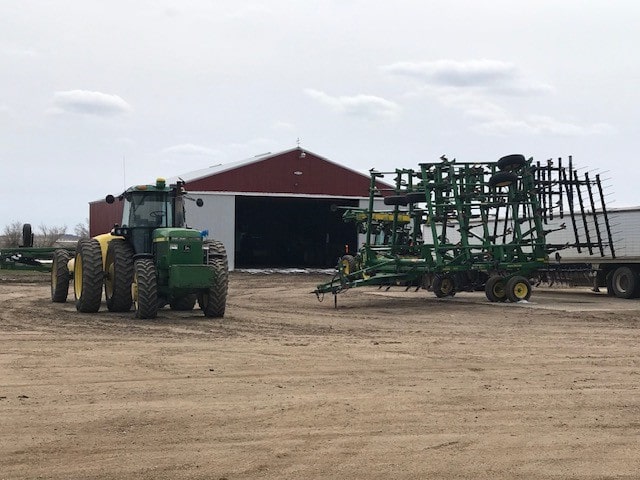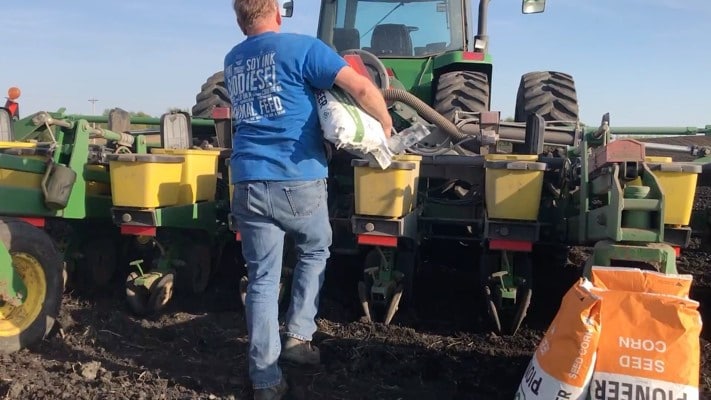Author: Wanda Patsche
Did you know spring planting starts long before spring? That’s right. Farmers need to spend a lot of time planning and preparing for the spring planting season. Much of the planning is done the previous fall and throughout the winter. Farmers make plans on what crop to plant, what type of seed to plant and where to plant it.
Many farms rotate their crops which means they plant a crop one year and then another crop the following year. For example, we plant corn one year and then soybeans the next. Rotating crops is a good farming practice and good for soil health.
Another decision that is made is where and what to apply for soil nutrients and crop protectants. Each crop requires different soil nutrients. For example, hog farmers will apply hog manure on land in the fall after harvest. Corn is the best crop to grow on land where manure was applied because of the nutrient value manure has and the nutrients corn needs to grow.
What crops do farmers plant?

Decisions on what seeds to plant is also done early, usually during the winter months. Farmers will analyze their crops by looking at what crops grew well. Each field can have different growing conditions and soil characteristics. If the crops did not do well as expected, farmers can work with an agronomist and problem solve to find the reason. Was it the weather too hot or too cold? Were there insect problems? Did the soil have an appropriate amount of soil nutrients? Based on the analysis, farmers can make good decisions for spring. All seed corn has different traits which will help a farmer decide which type of corn to plant. For example, a certain trail might be drought-tolerance, which would be a good seed to plant in areas that don’t receive sufficient rainfall. Did you know that farmers also attend school? That’s right. Many of the classes farmers go to help them learn about new technologies better ways to farm. Farmers care deeply about their soils, water and environment. Using new and better practices into place is good for all of us.
It's Spring, Now What?

All crop inputs are delivered to farm in early spring. Here is a video of seed corn delivered to the farm.
Farmers spend quite amount of time working on machinery to make sure it is working properly. Spring planting requires different machines to put seeds into the ground. Many farms use a field cultivator which dig up the soil before planting (like a really big rototiller), sprayers which will spray a crop protectant to help keep weeds from growing, and a seed planter.

All the machinery needs to be calibrated so the proper amounts of seed and crop protectant is applied to the soils. Farmers keep accurate records to make sure not too much herbicide is applied.
It's Time to Plant!

Before a farmer can plant, they need to make sure the fields are not too wet and the temperature is warm enough for seeds to grow. Probably one of the most exciting times is filling the corn planter! Watch this video as seed is put into a corn planter that plants 18 rows at a time.
Spring is a very busy time of year. Farmers are excited about starting a new crop and watching it grow! Farmers know they are growing food and fuel and understand it’s a big responsibility to help feed the world.
Teacher Resources
There are numerous MN Ag in the Classroom lessons that can be used via elearning. Some may need some adaptations. Please reach out to me if you would like me to help with those adaptations. [email protected]
Lesson Resources:
K-2:
People and Plants Need Nutrients. In this lesson, students will learn that although plants and people obtain nutrients differently, they both need proper amounts of nutrients to grow and be healthy.
Sunflower Life Cycles. Introduce your kids to the seed cycle and allow them to create a sunflower of their own.
Green House Challenge Make the most of your time stuck at home…learn a new skill! Join our challenge & grow your own food!
Online AgMag – Plants Have Many Parts (for Gr 2.)
Gr 3-5
Caring for the Land. Students will explain why people have different opinions regarding soil management and identify cause and effect relationships relating to agriculture and the environment.
Wad-a-Watershed. Students will be able to understand the basic geography of a watershed, how water flows through the system, and how people can impact the quality of our water. This could be done as a group project using Zoom.
Online AgMag – Specialty Crops (Gr 3)
Online AgMag – Talking Corn and Soybeans (Gr 4-6)
Green House Challenge Make the most of your time stuck at home…learn a new skill! Join our challenge & grow your own food!
Gr 6-8
Digging into Nutrients In this lesson, students will gain background knowledge of the nutrient requirements of plants, how those nutrients are obtained by the plant, what farmers must do if the nutrients are not available in soils, and current issues related to agricultural production.
Gr 9-12
Agricultural Land Use Students explore the impact of fertilizer on algae growth, soil erosion, and agricultural soil and water conservation practices.
From Boom to Dust. Students will learn how the events of World War I helped spark the Great Depression, the Dust Bowl, and the resulting New Deal by watching a video and participating in a round robin, responding in writing to images and sound bites from the Dust Bowl, and observing a wind erosion demonstration.
Other online educational links:
